Journal Article
Publication Types:
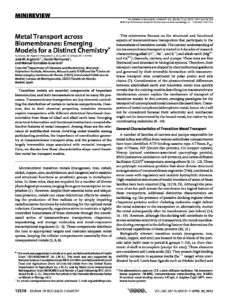
Metal transport across biomembranes: emerging models for a distinct chemistry
Abstract
Transition metals are essential components of important biomolecules, and their homeostasis is central to many life processes. Transmembrane transporters are key elements controlling the distribution of metals in various compartments. However, due to their chemical properties, transition elements require transporters with different structural-functional characteristics from those of alkali and alkali earth ions. Emerging structural information and functional studies have revealed distinctive features of metal transport. Among these are the relevance of multifaceted events involving metal transfer among participating proteins, the importance of coordination geometry at transmembrane transport sites, and the presence of the largely irreversible steps associated with vectorial transport. Here, we discuss how these characteristics shape novel transition metal ion transport models.
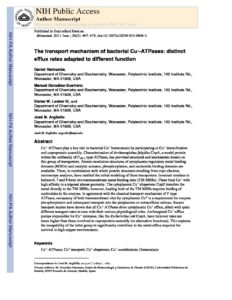
The transport mechanism of bacterial Cu+-ATPasess: distinct efflux rates adapted to different function
Abstract
Cu+-ATPases play a key role in bacterial Cu+ homeostasis by participating in Cu+ detoxification and cuproprotein assembly. Characterization of Archaeoglobus fulgidus CopA, a model protein within the subfamily of P1B-1 type ATPases, has provided structural and mechanistic details on this group of transporters. Atomic resolution structures of cytoplasmic regulatory metal binding domains (MBDs) and catalytic actuator, phosphorylation, and nucleotide binding domains are available. These, in combination with whole protein structures resulting from cryo-electron microscopy analyses, have enabled the initial modeling of these transporters. Invariant residues in helixes 6, 7 and 8 form two transmembrane metal binding sites (TM-MBSs). These bind Cu+ with high affinity in a trigonal planar geometry. The cytoplasmic Cu+ chaperone CopZ transfers the metal directly to the TM-MBSs; however, loading both of the TM-MBSs requires binding of nucleotides to the enzyme. In agreement with the classical transport mechanism of P-type ATPases, occupancy of both transmembrane sites by cytoplasmic Cu+ is a requirement for enzyme phosphorylation and subsequent transport into the periplasmic or extracellular milieus. Recent transport studies have shown that all Cu+-ATPases drive cytoplasmic Cu+ efflux, albeit with quite different transport rates in tune with their various physiological roles. Archetypical Cu+-efflux pumps responsible for Cu+ tolerance, like the Escherichia coli CopA, have turnover rates ten times higher than those involved in cuproprotein assembly (or alternative functions). This explains the incapability of the latter group to significantly contribute to the metal efflux required for survival in high copper environments.

Bacterial transition metal P1B-ATPases: transport mechanism and roles in virulence
Abstract
P1B-type ATPases are polytopic membrane proteins that couple the hydrolysis of ATP to the efflux of cytoplasmic transition metals. This article reviews recent progress in our understanding of the structure and function of these proteins in bacteria. These are members of the P-type superfamily of transport ATPases. Cu+-ATPases are the most frequently observed and best-characterized members of this group of transporters. However, bacterial genomes show diverse arrays of P1B-type ATPases with a range of substrates (Cu+, Zn2+, Co2+). Furthermore, because of the structural similarities among transitions metals, these proteins can also transport non-physiological substrates (Cu2+, Cd2+, Pb2+, Au+, Ag+). P1B-type ATPases have six or eight transmembrane segments (TM) with metal coordinating amino acids in three core TMs flanking the cytoplasmic domain responsible for ATP binding and hydrolysis. In addition, regulatory cytoplasmic metal binding domains are present in most P1B-type ATPases. Central to the transport mechanism is the binding of the uncomplexed metal to these proteins when cytoplasmic substrates are bound to chaperone and chelating molecules. Metal binding to regulatory sites is through a reversible metal exchange among chaperones and cytoplasmic metal binding domains. In contrast, the chaperone-mediated metal delivery to transport sites appears as a largely irreversible event. P1B-ATPases have two overarching physiological functions: to maintain cytoplasmic metal levels and to provide metals for the periplasmic assembly of metalloproteins. Recent studies have shown that both roles are critical for bacterial virulence, since P1B-ATPases appear key to overcome high phagosomal metal levels and are required for the assembly of periplasmic and secreted metalloproteins that are essential for survival in extreme oxidant environments.
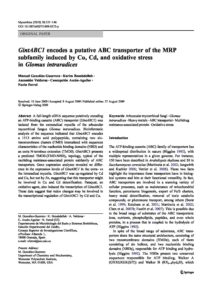
GintABC1 encodes a putative ABC transporter of the MRP subfamily induced by Cu, Cd and oxidative stress in Glomus intraradices
Abstract
A full-length cDNA sequence putatively encoding an ATP-binding cassette (ABC) transporter (GintABC1) was isolated from the extraradical mycelia of the arbuscular mycorrhizal fungus Glomus intraradices. Bioinformatic analysis of the sequence indicated that GintABC1 encodes a 1513 amino acid polypeptide, containing two six-transmembrane clusters (TMD) intercalated with sequences characteristics of the nucleotide binding domains (NBD) and an extra N-terminus extension (TMD0). GintABC1 presents a predicted TMD0-(TMD-NBD)2 topology, typical of the multidrug resistance-associated protein subfamily of ABC transporters. Gene expression analyses revealed no difference in the expression levels of GintABC1 in the extra- vs the intraradical mycelia. GintABC1 was up-regulated by Cd and Cu, but not by Zn, suggesting that this transporter might be involved in Cu and Cd detoxification. Paraquat, an oxidative agent, also induced the transcription of GintABC1. These data suggest that redox changes may be involved in the transcriptional regulation of GintABC1 by Cd and Cu.

Distinct functional roles of homologous Cu+ efflux ATPases in Pseudomonas aeruginosa
Abstract
In bacteria, most Cu+-ATPases confer tolerance to Cu by driving cytoplasmic metal efflux. However, many bacterial genomes contain several genes coding for these enzymes suggesting alternative roles. Pseudomonas aeruginosa has two structurally similar Cu+-ATPases, CopA1 and CopA2. Both proteins are essential for virulence. Expressed in response to high Cu, CopA1 maintains the cellular Cu quota and provides tolerance to this metal. CopA2 belongs to a subgroup of ATPases that are expressed in association with cytochrome oxidase subunits. Mutation of copA2 has no effect on Cu toxicity nor intracellular Cu levels; but it leads to higher H2O2 sensitivity and reduced cytochrome oxidase activity. Mutation of both genes does not exacerbate the phenotypes produced by single-gene mutations. CopA1 does not complement the copA2 mutant strain and vice versa, even when promoter regions are exchanged. CopA1 but not CopA2 complements an Escherichia coli strain lacking the endogenous CopA. Nevertheless, transport assays show that both enzymes catalyse cytoplasmic Cu+efflux into the periplasm, albeit CopA2 at a significantly lower rate. We hypothesize that their distinct cellular functions could be based on the intrinsic differences in transport kinetic or the likely requirement of periplasmic partner Cu-chaperone proteins specific for each Cu+-ATPase.
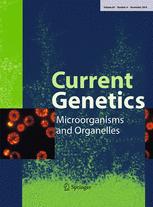
Characterization of a Cu,Zn superoxide dismutase gene in the arbuscular mycorrhizal fungus Glomus intraradices
Abstract
To gain further insights into the mechanisms of redox homeostasis in arbuscular mycorrhizal fungi, we characterized a Glomus intraradices gene (GintSOD1) showing high similarity to previously described genes encoding CuZn superoxide dismutases (SODs). The GintSOD1 gene consists of an open reading frame of 471 bp, predicted to encode a protein of 157 amino acids with an estimated molecular mass of 16.3 kDa. Functional complementation assays in a CuZnSOD-defective yeast mutant showed that GintSOD1 protects the yeast cells from oxygen toxicity and that it, therefore, encodes a protein that scavenges reactive oxygen species (ROS). GintSOD1 transcripts differentially accumulate during the fungal life cycle, reaching the highest expression levels in the intraradical mycelium. GintSOD1 expression is induced by the well known ROS-inducing agents paraquat and copper, and also by fenpropimorph, a sterol biosynthesis inhibitor (SBI) fungicide. These results suggest that GintSOD1 is involved in the detoxification of ROS generated from metabolic processes and by external agents. In particular, our data indicate that the antifungal effects of fenpropimorph might not be only due to the interference with sterol metabolism but also to the perturbation of other biological processes and that ROS production and scavenging systems are involved in the response to SBI fungicides.
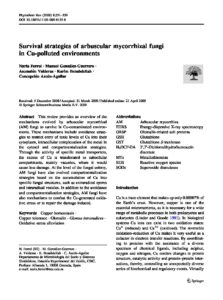
Survival strategies of arbuscular mycorrhizal fungi in Cu-polluted environments
Abstract
This review provides an overview of the mechanisms evolved by arbuscular mycorrhizal (AM) fungi to survive in Cu-contaminated environments. These mechanisms include avoidance strategies to restrict entry of toxic levels of Cu into their cytoplasm, intracellular complexation of the metal in the cytosol and compartmentalization strategies. Through the activity of specific metal transporters, the excess of Cu is translocated to subcellular compartments, mainly vacuoles, where it would cause less damage. At the level of the fungal colony, AM fungi have also evolved compartmentalization strategies based on the accumulation of Cu into specific fungal structures, such as extraradical spores and intraradical vesicles. In addition to the avoidance and compartmentalization strategies, AM fungi have also mechanisms to combat the Cu-generated oxidative stress or to repair the damage induced.
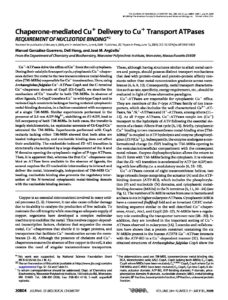
Chaperone-mediated Cu+ delivery to Cu+ transport ATPases: requirement of nucleotide binding
Abstract
Cu+-ATPases drive the efflux of Cu+ from the cell cytoplasm. During their catalytic/transport cycle, cytoplasmic Cu+-chaperones deliver the metal to the two transmembrane metal-binding sites (TM-MBSs) responsible for Cu+ translocation. Here, using Archaeoglobus fulgidus Cu+-ATPase CopA and the C-terminal Cu+-chaperone domain of CopZ (Ct-CopZ), we describe the mechanism of Cu+ transfer to both TM-MBSs. In absence of other ligands, Ct-CopZ transfers Cu+ to wild-type CopA and to various CopA constructs lacking or having mutated cytoplasmic metal-binding domains, in a fashion consistent with occupancy of a single TM-MBS. Similar experiments performed in the presence of 2.5 mM ADP-Mg2+, stabilizing an E1·ADP, lead to full occupancy of both TM-MBSs. In both cases, the transfer is largely stoichiometric, i.e. equimolar amounts of Ct-CopZ·Cu+saturated the TM-MBSs. Experiments performed with CopA mutants lacking either TM-MBS showed that both sites are loaded independently, and nucleotide binding does not affect their availability. The nucleotide-induced E2→E1 transition is structurally characterized by a large displacement of the A and N domains opening the cytoplasmic region of P-type ATPases. Then, it is apparent that, whereas the first Cu+-chaperone can bind an ATPase form available in the absence of ligands, the second requires the E1·nucleotide intermediary to interact and deliver the metal. Interestingly, independent of TM-MBS Cu+ loading, nucleotide binding also prevents the regulatory interaction of the N-terminal cytoplasmic metal-binding domain with the nucleotide binding domain.
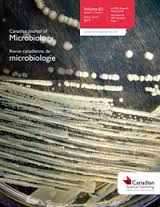
Ultrastructural localization of heavy metals in the extraradical mycelium and spores of the arbuscular mycorrhizal Glomus intraradices
Abstract
Arbuscular mycorrhizal fungi, obligate symbionts of most plant species, are able to accumulate heavy metals, thereby, protecting plants from metal toxicity. In this study, the ultrastructural localization of Zn, Cu, and Cd in the extraradical mycelium and spores of the arbuscular mycorrhizal fungus Glomus intraradices grown in monoxenic cultures was investigated. Zinc, Cu, or Cd was applied to the extraradical mycelium to final concentrations of 7.5, 5.0, or 0.45 mmol/L, respectively. Samples were collected at time 0, 8 h, and 7 days after metal application and were prepared for rapid freezing and freeze substitution. Metal content in different subcellular locations (wall, cytoplasm, and vacuoles), both in hyphae and spores, was determined by energy-dispersive X-ray spectroscopy. In all treatments and fungal structures analysed, heavy metals accumulated mainly in the fungal cell wall and in the vacuoles, while minor changes in metal concentrations were detected in the cytoplasm. Incorporation of Zn into the fungus occurred during the first 8 h after metal addition with no subsequent accumulation. On the other hand, Cu steadily accumulated in the spore vacuoles over time, whereas Cd steadily accumulated in the hyphal vacuoles. These results suggest that binding of metals to the cell walls and compartmentalization in vacuoles may be essential mechanisms for metal detoxification.

Structure of the two transmembrane Cu+ transport sites of the Cu+-ATPases
Abstract
Cu+-ATPases drive metal efflux from the cell cytoplasm. Paramount to this function is the binding of Cu+ within the transmembrane region and its coupled translocation across the permeability barrier. Here, we describe the two transmembrane Cu+ transport sites present in Archaeoglobus fulgidus CopA. Both sites can be independently loaded with Cu+. However, their simultaneous occupation is associated with enzyme turnover. Site I is constituted by two Cys in transmembrane segment (TM) 6 and a Tyr in TM7. An Asn in TM7 and Met and Ser in TM8 form Site II. Single site x-ray spectroscopic analysis indicates a trigonal coordination in both sites. This architecture is distinct from that observed in Cu+-trafficking chaperones and classical cuproproteins. The high affinity of these sites for Cu+ (Site I Ka = 1.3 fM–1, Site II Ka = 1.1 fM–1), in conjunction with reversible direct Cu+ transfer from chaperones, points to a transport mechanism where backward release of free Cu+ to the cytoplasm is largely prevented.
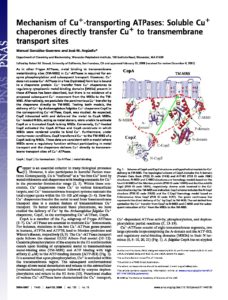
Mechanism of Cu+-transporting ATPases: Soluble Cu+ chaperones directly transfer Cu+ to transmembrane transport sites
Abstract
As in other P-type ATPases, metal binding to transmembrane metal-binding sites (TM-MBS) in Cu+-ATPases is required for enzyme phosphorylation and subsequent transport. However, Cu+ does not access Cu+-ATPases in a free (hydrated) form but is bound to a chaperone protein. Cu+ transfer from Cu+chaperones to regulatory cytoplasmic metal-binding domains (MBDs) present in these ATPases has been described, but there is no evidence of a proposed subsequent Cu+ movement from the MBDs to the TM-MBS. Alternatively, we postulate the parsimonious Cu+ transfer by the chaperone directly to TM-MBS. Testing both models, the delivery of Cu+ by Archaeoglobus fulgidus Cu+ chaperone CopZ to the corresponding Cu+-ATPase, CopA, was studied. As expected, CopZ interacted with and delivered the metal to CopA MBDs. Cu+-loaded MBDs, acting as metal donors, were unable to activate CopA or a truncated CopA lacking MBDs. Conversely, Cu+-loaded CopZ activated the CopA ATPase and CopA constructs in which MBDs were rendered unable to bind Cu+. Furthermore, under nonturnover conditions, CopZ transferred Cu+ to the TM-MBS of a CopA lacking MBDs. These data are consistent with a model where MBDs serve a regulatory function without participating in metal transport and the chaperone delivers Cu+directly to transmembrane transport sites of Cu+-ATPases.z

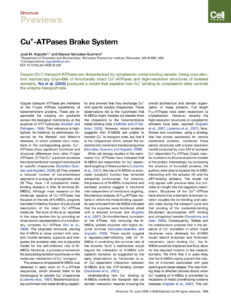
Abstract
Copper (Cu+) transport ATPases are characterized by cytoplasmic metal-binding repeats. Using cryo-electron microscopy (cryo-EM) of functionally intact Cu+-ATPases and high-resolution structures of isolated domains, Wu et al. (2008) produced a model that explains how Cu+ binding to cytoplasmic sites controls the enzyme transport rate.

The structure and function of heavy metal transport P1B-ATPases
Abstract
P1B-type ATPases transport heavy metals (Cu+, Cu2+, Zn2+, Co2+, Cd2+, Pb2+) across membranes. Present in most organisms, they are key elements for metal homeostasis. P1B-type ATPases contain 6-8 transmembrane fragments carrying signature sequences in segments flanking the large ATP binding cytoplasmic loop. These sequences made possible the differentiation of at least four P1B-ATPase subgroups with distinct metal selectivity: P1B-1: Cu+, P1B-2: Zn2+, P1B-3: Cu2+, P1B-4: Co2+. Mutagenesis of the invariant transmembrane Cys in H6, Asn and Tyr in H7 and Met and Ser in H8 of the Archaeoglobus fulgidus Cu+-ATPase has revealed that their side chains likely coordinate the metals during transport and constitute a central unique component of these enzymes. The structure of various cytoplasmic domains has been solved. The overall structure of those involved in enzyme phosphorylation (P-domain), nucleotide binding (N-domain) and energy transduction (A-domain), appears similar to those described for the SERCA Ca2+-ATPase. However, they show different features likely associated with singular functions of these proteins. Many P1B-type ATPases, but not all of them, also contain a diverse arrangement of cytoplasmic metal binding domains (MBDs). In spite of their structural differences, all N- and C-terminal MBDs appear to control the enzyme turnover rate without affecting metal binding to transmembrane transport sites. In addition, eukaryotic Cu+-ATPases have multiple N-MBD regions that participate in the metal dependent targeting and localization of these proteins. The current knowledge of structure-function relationships among the different P1B-ATPases allows for a description of selectivity, regulation and transport mechanisms. Moreover, it provides a framework to understand mutations in human Cu+-ATPases (ATP7A and ATP7B) that lead to Menkes and Wilson diseases.
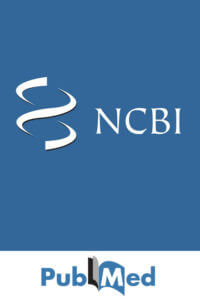
Novel Zn2+ coordination by the regulatory N-terminus metal binding domain of Arabidopsis thaliana Zn2+-ATPase HMA2
Abstract
Arabidopsis thaliana HMA2 is a Zn2+ transporting P1B-type ATPase required for maintaining plant metal homeostasis. HMA2 and all eukaryote Zn2+-ATPases have unique conserved N- and C-terminal sequences that differentiate them from other P1B-type ATPases. Homology modeling and structural comparison by circular dichroism indicate that the 75 amino acid long HMA2 N-terminus shares the betaalphabetabetaalpha folding present in most P1B-type ATPase N-terminal metal binding domains (N-MBDs). However, the characteristic metal binding sequence CysXXCys is replaced by Cys17CysXXGlu21, a sequence present in all plant Zn2+-ATPases. The isolated HMA2 N-MBD fragment binds a single Zn2+ (Kd 0.18 microM), Cd2+ (Kd 0.27 microM), or, with less affinity, Cu+ (Kd 13 microM). Mutagenesis studies indicate that Cys17, Cys18, and Glu21 participate in Zn2+ and Cd2+ coordination, while Cys17 and Glu21, but not Cys18, are required for Cu+ binding. Interestingly, the Glu21Cys mutation that generates a CysCysXXCys site is unable to bind Zn2+ or Cd2+ but it binds Cu+ with affinity (Kd 1 microM) higher than wild type N-MBD. Truncated HMA2 lacking the N-MBD showed reduced ATPase activity without significant changes in metal binding to transmembrane metal binding sites. Likewise, ATPase activity of HMA2 carrying mutations Cys17Ala, Cys18Ala, and Glu21Ala/Cys was also reduced but showed a metal dependence similar to the wild type enzyme. These observations suggest that plant Zn2+-ATPase N-MBDs have a folding and function similar to Cu+-ATPase N-MBDs. However, the unique Zn2+ coordination via two thiols and a carboxyl group provides selective binding of the activating metals to these regulatory domains. Metal binding through these side chains, although found in different sequences, appears as a common feature of both bacterial and eukaryotic Zn2+-ATPase N-MBDs.

GintMT1 encodes a functional metallothionein in Glomus intraradices that responds to oxidative stress
Abstract
A full-length metallothionein (MT) gene (GintMT1) was isolated from Glomus intraradices extraradical mycelium. This is the first MT gene reported in the genus Glomus, third in the Glomeromycota. Functional analysis of GintMT1 in a MT-defective Saccharomyces cerevisiae strain indicates that it encodes a functional MT. Gene expression analyses revealed that the transcript levels of GintMT1 were elevated in mycelia treated with 5 mM Cu or paraquat but inhibited in mycelia treated with 50 μM Cu or 450 μM Cd. The elevated expression of GintMT1 in the 5 mM Cu-treated mycelia together with the ability of GintMT1 to provide tolerance to a Cu-sensitive yeast suggests that GintMT1 might afford protection against Cu. Induction of GintMT1 expression by paraquat and 5 mM Cu, treatments that also produced an oxidative damage to the fungal membranes, suggests that GintMT1 may play a role in the regulation of the redox status of the extraradical mycelium of G. intraradices.
